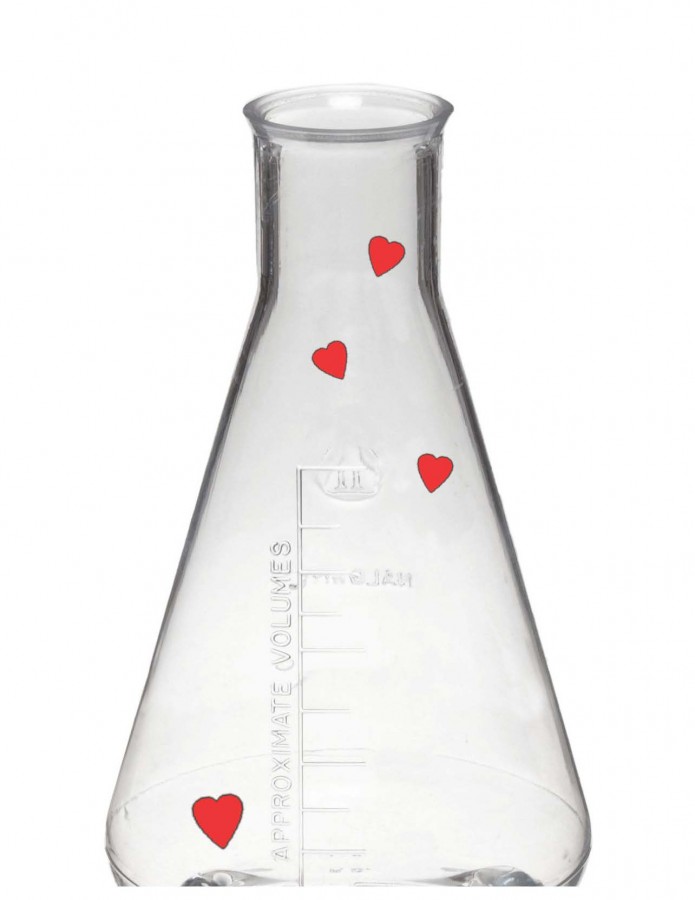The Science of Love
March 24, 2015
Imagine you’re in Mr. Lebo’s classroom. You look across the lab bench at another student working away at their station, pouring toxic substances into a swirling solution. You lock your protective goggled-eyes through the fumes billowing through the air. You might think it’s the electricity, you might think it’s the fumes getting to you, maybe you believe it’s love, but you’re wrong… It’s chemistry.
Love is a powerful thing. It changes lives, starts wars, breaks hearts and opens them. Love is the inspiration to nearly every song in popular culture, and a major grievance of angsty teenagers worldwide. In essence, love is a mystery. Scientists have been trying to solve this mystery for years and now have answers. What is the science behind love? What makes us fall madly for each other? It’s really not too complicated.
Smell the Roses…or the Pheromones
Have you ever heard the saying, “love at first sight?” It should really be, “love at first sniff.” Your nose knows more than you think it does. When you initially approach someone, you and your nose naturally pick up these little, odorless signals called pheromones. Pheromones are one of the biggest players in terms of falling for that special someone. A pheromone is a chemical excreted through bodily fluids, like sweat. Not like that wonderfully musky cologne or fabulously fine perfume that you happen to catch a whiff of when someone passes by, but rather a smell that your brain picks up subconsciously. While there are many other factors in the science of falling in love, pheromones do a pretty hefty portion of the work. These little chemicals are completely invisible and odorless and are silently passed from the nose to the brain. Pheromones can almost immediately change a person’s actions or thoughts, without their knowing. As another person’s pheromones go from their body to your brain, your subconscious thoughts are working away to figure out whether or not this person could be right for you.
The Eyes Have It-Secrets of Visual Attraction
People in general are attracted to symmetry. Symmetrical features are advertising a person’s genetic health. To a heterosexual woman, taller men with broad shoulders are more attractive, according to extensive scientific studies. This can be attributed to her subconscious interest in his potential ability to protect her and her children that is rooted in her evolutionary instincts. Likewise, heterosexual men look for women with an ‘hourglass’ figure as it provides clues to the woman in question’s ability to bear children. Although the above factors are scientific explanations of attraction they do not dictate what makes someone beautiful to someone else.
The Inside Scoop– Immune System
Ever had that feeling in the pit of your stomach when that special someone passes by? The inner workings of your body might have more to do with attraction than we think. People are attracted to potential mates who have a different Major Histocompatibility Complex, or MHC, molecule makeup. MHC molecules determine the makeup of your immune system. Partners with different MHC makeups tend to produce offspring with more diverse immune systems. The children of these pairs are able to handle a wider range of diseases and thus are more likely to survive. This phenomenon was first discovered in an experiment by Swiss zoologist, Claus Wedekind, in which women were asked to smell the t-shirts worn by different men and rate them regarding attractiveness. The women tended to rate men with differing MHC signature’s as more attractive. Who says that beauty is skin deep?
Love is an instinct, deeply ingrained in the human psyche. Its goal, from an evolutionary perspective is to ensure that our genes are passed on to the next generation. A collection of chemicals and subconscious cues get the job done. But, is it possible that some things are worth more than the sum of their parts? When it comes to this most potent of human experiences we seem to believe that it is, it certainly feels like it.

